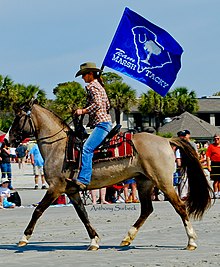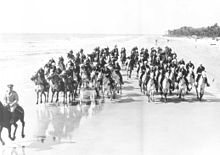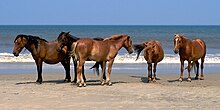Carolina Marsh Tacky
 Carolina Marsh Tacky at Hilton Head | |
| Other names | Marsh Tacky |
|---|---|
| Country of origin | United States |
| Traits | |
| Distinguishing features | Small, sure-footed horse with gentle disposition, adept at work in marshland. |
| Breed standards | |
The Carolina Marsh Tacky or Marsh Tacky is a
The breed is considered to be critically endangered by both the
On June 11, 2010, a bill was signed into law that made the Carolina Marsh Tacky the official
Characteristics
The Marsh Tacky generally stands between 14 and 14.2
The Marsh Tacky is known by owners for its stamina and ability to work in water and swamps without panicking. They tend to be
Marsh Tackies have the same ancestral bloodlines as Florida Cracker Horses and North Carolina Banker horses. However, DNA testing has proved that the Marsh Tackies' relative isolation has made them a separate breed with unique characteristics.[7]
History

The Carolina Marsh Tacky developed from
In 2007, the Carolina Marsh Tacky Association was formed. The association was developed through the efforts of the
In 2015, a complete, articulated horse skeleton believed to be a Marsh Tacky was unearthed at an archaeological dig in St. Augustine, Florida.[10] The approximately 200-year-old skeleton was found on the site which once housed the Spanish Dragoon Barracks.
Conservation

In the lowcountry region of coastal Georgia and South Carolina, the Carolina Marsh Tacky was the most common horse for most of the breed's history. As the automobile became more common during the 20th century, breed numbers declined, and the Marsh Tacky was thought to have gone extinct during the 1980s and 1990s.[6] Today, there are 276 living animals recognized by the breed registry, including 153 mares and 123 stallions and geldings.[9]
The Equus Survival Trust considers the breed to be at critical/nearly extinct levels, meaning that there are fewer than 100 breeding mares in existence.[11] The American Livestock Breeds Conservancy considers the Marsh Tacky (which they consider a strain of the Colonial Spanish horse) to be at critical levels, meaning that there are fewer than 200 annual registrations in the United States and an estimated global population of less than 2,000.[12] Representatives of the ALBC state that the breed numbers will have to increase to an estimated 1,000 members to ensure permanent survival.[7]
On June 11, 2010, a bill was signed into law that made the Carolina Marsh Tacky the official
In 2006, the ALBC began investigating the Marsh Tacky to see if it was truly a descendant of Spanish stock, and during the organization's initial field investigations it was found that many surviving members of the breed fit the physical type of Colonial Spanish stock.
See also
References
- ^ "Conservation Priority List". The Livestock Conservancy. Retrieved 23 June 2023.
- ^ "State Heritage Horse". Carolina Marsh Tacky Association. Retrieved 2011-02-04.
- ^ a b "Marsh Tacky Breed Standard". Carolina Marsh Tacky Association. Retrieved 2009-10-02.
- ^ a b c d Beranger, Jeannette. "The Marsh Tacky Horse — Yesterday and Today". Carolina Marsh Tacky Association. Retrieved 2009-10-02.
- ^ Nicodemus, Molly; Beranger, Jeannette (January–February 2010). "Exciting Research on the Gait of Colonial Spanish Horses". American Livestock Breeds Conservancy. Retrieved 2011-02-04.
- ^ a b c d e f Beranger, Jeannette. "ALBC Works with Owners and Others to Conserve the Critically Endangered Marsh Tacky Horse". American Livestock Breeds Conservancy. Retrieved 2009-10-02.
- ^ a b The Associated Press (April 15, 2008). "Carolina Horsemen Trying to Save Rare Breed". The Horse. Retrieved 2009-10-02.
- ^ "About Us". Carolina Marsh Tacky Association. Retrieved 2009-10-02.
- ^ a b "The Marsh Tacky Registry Update Spring 2011". Carolina Marsh Tacky Horse Registry. Retrieved 2012-01-23.
- ^ Entire horse skeleton found in archaeological dig
- ^ "Equine Conservation List" (PDF). Equine Survival Trust. Retrieved 2009-10-02.
- ^ "Conservation Priority Equine Breeds 2009" (PDF). American Livestock Breeds Conservancy. Retrieved 2009-10-02.
- ^ Hampton, Jeff (3 June 2010). "Wild horses set to become North Carolina state horse". The Virginian-Pilot. Retrieved 23 June 2023.
- ^ "Endangered Marsh Tacky Horses DNA Tested for Conservation Effort". The Horse. May 23, 2007. Retrieved 2009-02-17.
External links
